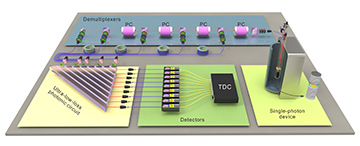 Experimental setup for multiphoton boson sampling, which includes a single-photon device, four demultiplexers using Pockels cells (PC), an ultra-low-loss photonic interferometer with 36 beam splitters, nine single-photon detectors and a time-to-digit converter (TDC) for data analysis.
Experimental setup for multiphoton boson sampling, which includes a single-photon device, four demultiplexers using Pockels cells (PC), an ultra-low-loss photonic interferometer with 36 beam splitters, nine single-photon detectors and a time-to-digit converter (TDC) for data analysis.
In principle, quantum computers can solve certain problems faster than classical computers. Yet, despite substantial progress in the past several decades, building quantum machines that can practically achieve “quantum supremacy,” outperforming classical computers for specific tasks, has remained challenging. Boson sampling, an intractable problem for classical computers, can be efficiently simulated by a multiphoton interferometer, and has therefore been considered a strong candidate to demonstrate quantum supremacy.
A quantum boson-sampling machine can be realized by inputting n indistinguishable single photons into an m-mode interferometer. When n ≥ 20, the quantum-optical device would reach a computational complexity that can challenge today’s best classical computers. Fundamentally, this would effectively disprove a foundational tenet in computer science: the Extended Church-Turing Thesis, which postulates that all realistic physical systems can be efficiently simulated with a classical probabilistic Turing machine.
The biggest challenge for implementing boson sampling with a large number of photons had been the lack of efficient single-photon sources and multiport photonic interferometers. Previous proof-of-principle experiments suffered from small photon number and low sampling rates. This year, we reported a deterministic single-photon source and a programmable multiphoton interferometer to implement boson sampling in a scalable architecture.1,2
Our source produces single photons from a single InGaAs quantum dot embedded inside a 2-μm-diameter micropillar, with a count rate of 9 MHz—the brightest single-photon source reported in any physical system to date. The single-photon stream is then actively demultiplexed into five spatial modes, which are fed into phase-stable multiphoton interferometers with a near-unity transmission rate to implement Haar-random unitary matrices.
We have implemented and validated 3-, 4- and 5-photon boson sampling, achieving sampling rates of 4.96 kHz, 151 Hz and 4 Hz, respectively. Those rates are more than 24,000 times faster than in previous experiments, and more than 220 times faster than obtaining one sample by calculating the permanents of the matrices using the first general-purpose programmable electronic computer, ENIAC, and the first transistorized computer, TRADIC. We believe that our work has demonstrated a clear, realistic pathway toward building boson-sampling machines with tens of photons and high efficiency, and that it marks a significant step toward an experimental regime approaching quantum supremacy.
Researchers
H. Wang, Y. He, X. Ding, Y.-M. He, C.-Y. Lu and J.-W. Pan, University of Science and Technology
of China, Hefei, China
C. Schneider and S. Höfling, University of Würzburg, Germany
References
1. H. Wang et al. Nat. Photon. 11, 361 (2017).
2. Y. He et al. Phys. Rev. Lett. 118, 190501 (2017).
